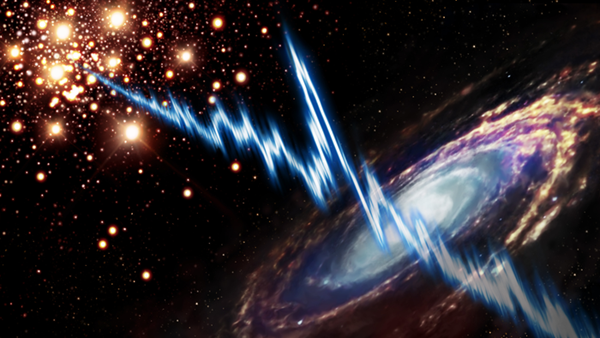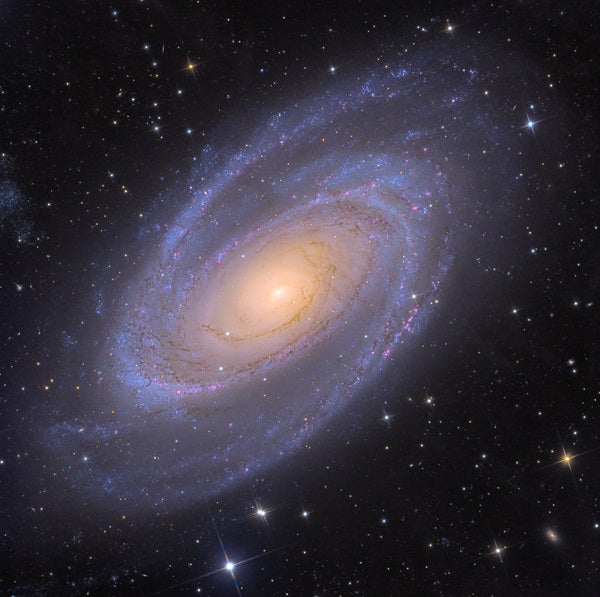Since 2007, astronomers have been working to unravel the mystery of brief, intense flashes of radio waves called fast radio bursts, or FRBs. In the ensuing decade and a half, they have surmised that these signals likely arise from a type of extremely magnetic neutron stars called magnetars.
Now, work published Feb. 23 in the journals Nature and Nature Astronomy raises new, interesting questions about these cosmic conundrums. An international team of researchers focused on studying a particular repeating FRB has announced two major findings: First, they’ve traced this FRB back to an unexpected place in its home galaxy. And second, the intense flashes are so short, they must be coming from a region just a few yards across.
Magnetic monsters
Astronomers currently believe FRBs are associated with magnetars, an extreme class of neutron stars. Magnetars’ magnetic fields are 100 to 1,000 times stronger than that of a typical neutron star, and some one thousand trillion times stronger than Earth’s magnetic field.
Neutron stars are already known for their small size, packing roughly the mass of the Sun into an object the size of Manhattan. This is one reason astronomers think FRBs might be associated with them. In this particular case, astronomers measured the bursts from their target (called FRB 20200120E) lasting as little as 60 nanoseconds, or 60 billionths of a second. That’s even shorter than usual for an FRB.
“That tells us that [the flashes] must be coming from a tiny volume in space, smaller than a soccer pitch and perhaps only tens of meters across,” said team co-leader Kenzie Nimmo, of ASTRON (the Netherlands Institute for Radio Astronomy) and the University of Amsterdam, in a press release.
These ultra-short, ultra-powerful bursts, the team notes, are similar to outbursts seen from a more run-of-the-mill neutron star, albeit a famous one: the neutron star at the center of the Crab Nebula (M1). These similarities, the team says, corroborate the idea that the bursts they recorded are from a magnetar, as expected. Further, they suggest that perhaps there is an entire class of ultra-short FRBs, like FRB 20200120E, yet to be discovered. After all, they note, most FRB searches aren’t designed to look for bursts on the scale of nano- or microseconds.
Strange origins
But that conclusion makes the team’s other find even less expected. Thanks to observations of multiple bursts from FRB 20200120E using several radio telescopes, the team tracked the signals back to their point of origin on the sky. This has only been accomplished for a few other FRBs, all located in regions of distant galaxies that house young, massive stars. That makes sense if FRBs come from magnetars, which are themselves the product of high-mass stars that quickly burn through all their fuel before blasting themselves apart.
FRB 20200120E lies in the galaxy M81, a massive spiral just 12 million light-years away. That makes it the closest source of FRBs detected to date — 40 times closer, in fact, than the previous record holder. That’s exciting on its own, but it’s where in M81 the researchers found FRB 20200120E that’s raising eyebrows: a dense, old grouping of stars known as a globular cluster.
This is not the place researchers expect to see magnetars, and not at all like the environments of all other known FRBs. Globular clusters are some of the oldest objects in the universe, full of aging stars, rather than young ones. “We expect magnetars to be shiny and new, and definitely not surrounded by old stars,” explained team member Jason Hessels, also of ASTRON and the University of Amsterdam.
According to the work, the location of FRB 20200120E challenges the current models of FRB emission, which state that activity in young magnetars only recently formed by a supernova powers these strange blasts. “If what we’re looking at here really is a magnetar, then it can’t have been formed from a young star exploding,” Hessels said. “There has to be another way.”
That other way could be a long-predicted but never-before-seen phenomenon, in which a white dwarf — the remnant of a Sun-like star — pulls mass from a companion and ultimately tips over a cosmic weight limit, collapsing into a denser neutron star. This is called accretion-induced collapse. Although posited to be rare in a dense region of stars like a globular cluster, it’s the simplest and likeliest explanation, the team says.
One other possibility, they add, is that the magnetar powering FRB 20200120E is instead the result of a binary merger between two compact objects, such as two white dwarfs, two neutron stars, or perhaps one of each. Such systems are common in globular clusters, and the result of a merger could also create a highly magnetized neutron star capable of creating FRBs.
For now, the mystery of FRB 20200120E’s origin remains. And regardless of the answer, this discovery indicates there are likely many ways to create the magnetars believed to power these strange objects. FRBs are continuing to teach astronomers that there is much to learn about how stars evolve — and just how much they can puzzle us, even after their deaths.











